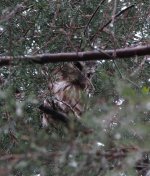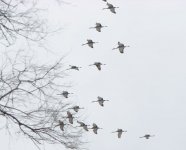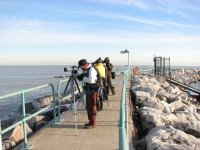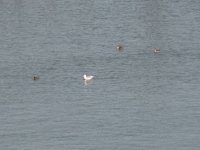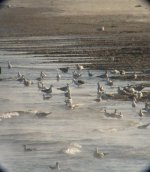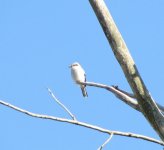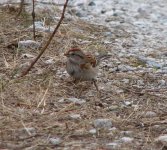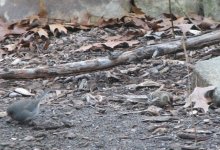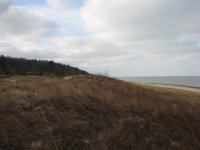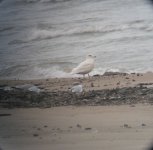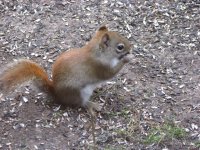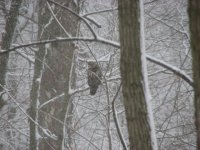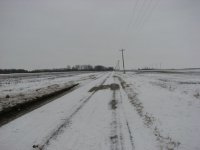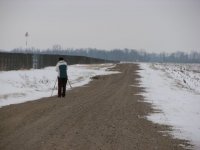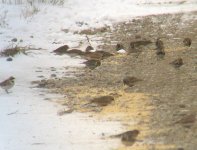Hamhed
Well-known member
It has been some time since I've written a trip report. Too busy, too lazy or too apathetic, whatever...call it a New Year resolution, here's one from a place few people think of birding:
Sometime in this past fall, Liz and I planned a December trip to northern Indiana to spend the holidays with family in Lafayette. It had been years since our last visit and also there was an underlying desire to see some of the wintering species of the midwest. I lurked on INBIRDS, the birding list serve for the state hosted by Purdue University, emailed Wes Homoya of Sycamore Audubon (http://sycamoreaudubon.org/) and Birding Pal member (http://www.birdingpal.org/) and studied our potential new species while the seasons changed to winter.
We left on the 19th of December, stopping once on our 9 hour drive to look for reported White-winged Crossbills at Eagle Creek Park in NW Indianapolis. After an hour, we had a good leg stretch and a taste of Indiana’s winter chill but no Crossbills.
The following morning, I connected with Delano Arvin who owns a good sized piece of Indiana woodland not far from Lafayette, including a few small groves of cedar trees. He regularly has Northern Saw-whet Owls using the groves as a winter roost and that morning confirmed there were several to be seen. An owl species we have heard on rare occasions in North Carolina’s higher elevations, seeing one would be another sensation altogether.
Within 30 minutes of reaching his property, we were looking at the first of two Saw-whets. They were both alert to our close presence but allowed us to get a few difficult pictures in the dull morning light. We also saw a Barred Owl who had less patience with us and flew off fairly quickly.
The balance of the day was spent catching up with family and paying attention to fresh winter storm warnings for the northern half of the state.
Nightfall brought an inch of snow to Lafayette. We were headed further north that day but reports were for limited snow cover there as well. Leaving in early afternoon, we stopped halfway to our destination at Jasper-Pulaski Fish and Wildlife Area, where the main attraction was a large number of wintering Greater Sandhill Cranes (Grus canadensis tabida). The view from the observation tower was of a low-lying, dry field, evidence of the severe drought conditions ongoing in this part of the country. We did see a good many small flocks of cranes flying, ostensibly to some hidden roost site. Other bird life was non-existent with the exception of a talkative Hairy Woodpecker.
We gained an hour as we crossed into the Central time zone as we drove but the elevation changed little in our two hour drive. Generally speaking, Lafayette is around 630 ft and Chesterton, our destination, is also 630 ft. After traveling past mile after mile of flat soybean and corn fields, we’re guessing the land between those towns is also 630 ft. Not long after dark, we reached the Spring House Inn
(www.springhouseinn.com/), just a few miles from the southern end of Lake Michigan.
Sometime in this past fall, Liz and I planned a December trip to northern Indiana to spend the holidays with family in Lafayette. It had been years since our last visit and also there was an underlying desire to see some of the wintering species of the midwest. I lurked on INBIRDS, the birding list serve for the state hosted by Purdue University, emailed Wes Homoya of Sycamore Audubon (http://sycamoreaudubon.org/) and Birding Pal member (http://www.birdingpal.org/) and studied our potential new species while the seasons changed to winter.
We left on the 19th of December, stopping once on our 9 hour drive to look for reported White-winged Crossbills at Eagle Creek Park in NW Indianapolis. After an hour, we had a good leg stretch and a taste of Indiana’s winter chill but no Crossbills.
The following morning, I connected with Delano Arvin who owns a good sized piece of Indiana woodland not far from Lafayette, including a few small groves of cedar trees. He regularly has Northern Saw-whet Owls using the groves as a winter roost and that morning confirmed there were several to be seen. An owl species we have heard on rare occasions in North Carolina’s higher elevations, seeing one would be another sensation altogether.
Within 30 minutes of reaching his property, we were looking at the first of two Saw-whets. They were both alert to our close presence but allowed us to get a few difficult pictures in the dull morning light. We also saw a Barred Owl who had less patience with us and flew off fairly quickly.
The balance of the day was spent catching up with family and paying attention to fresh winter storm warnings for the northern half of the state.
Nightfall brought an inch of snow to Lafayette. We were headed further north that day but reports were for limited snow cover there as well. Leaving in early afternoon, we stopped halfway to our destination at Jasper-Pulaski Fish and Wildlife Area, where the main attraction was a large number of wintering Greater Sandhill Cranes (Grus canadensis tabida). The view from the observation tower was of a low-lying, dry field, evidence of the severe drought conditions ongoing in this part of the country. We did see a good many small flocks of cranes flying, ostensibly to some hidden roost site. Other bird life was non-existent with the exception of a talkative Hairy Woodpecker.
We gained an hour as we crossed into the Central time zone as we drove but the elevation changed little in our two hour drive. Generally speaking, Lafayette is around 630 ft and Chesterton, our destination, is also 630 ft. After traveling past mile after mile of flat soybean and corn fields, we’re guessing the land between those towns is also 630 ft. Not long after dark, we reached the Spring House Inn
(www.springhouseinn.com/), just a few miles from the southern end of Lake Michigan.




